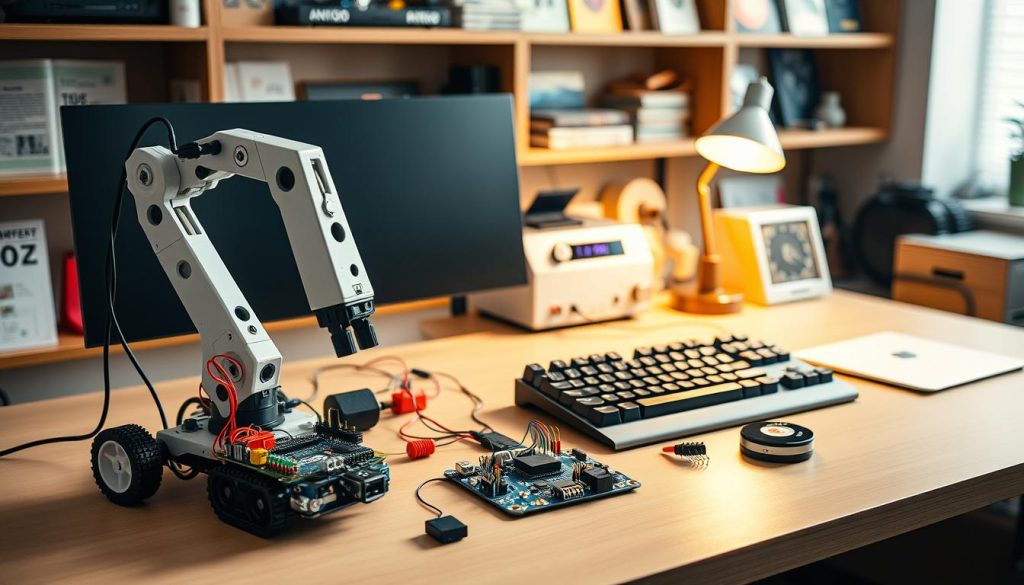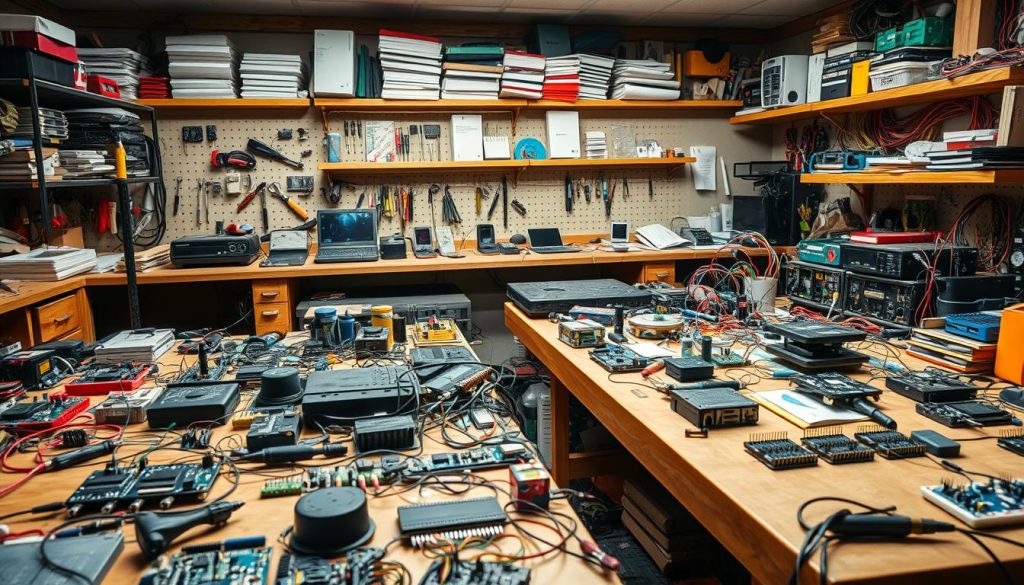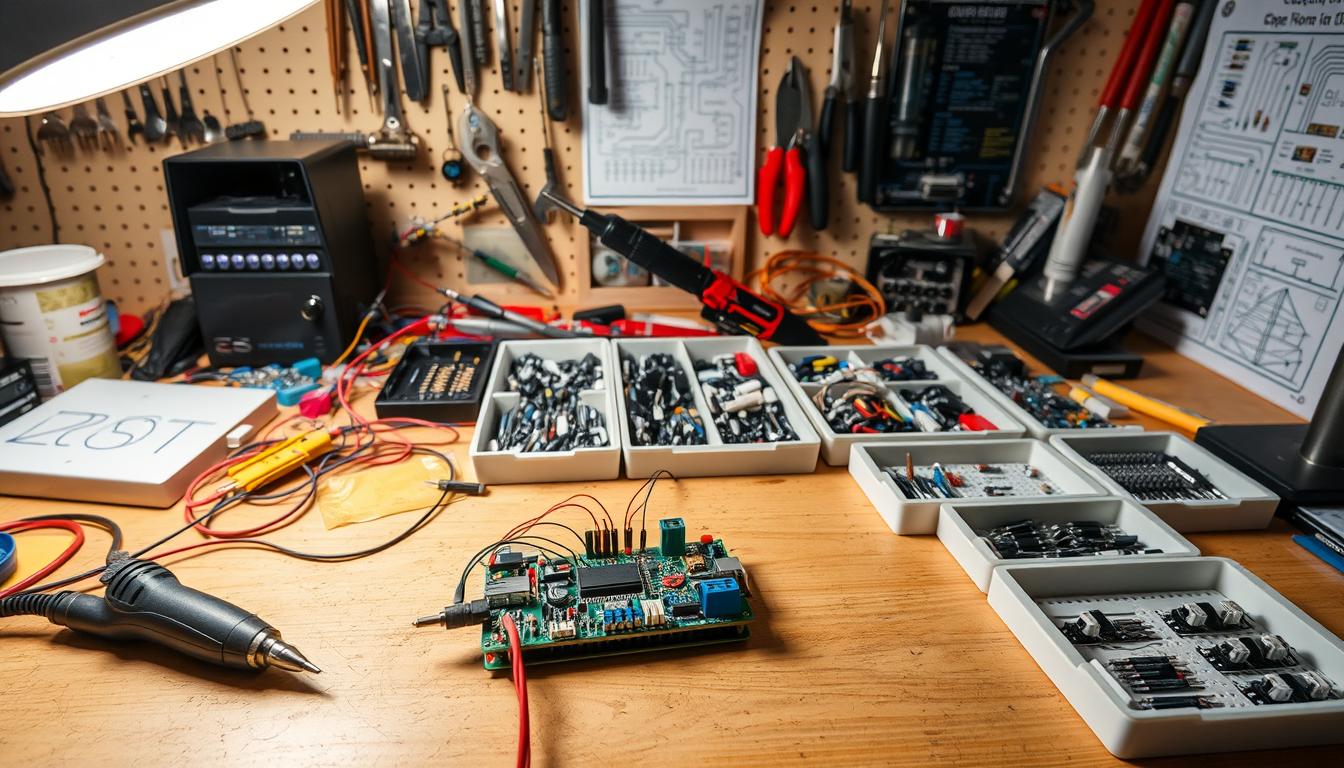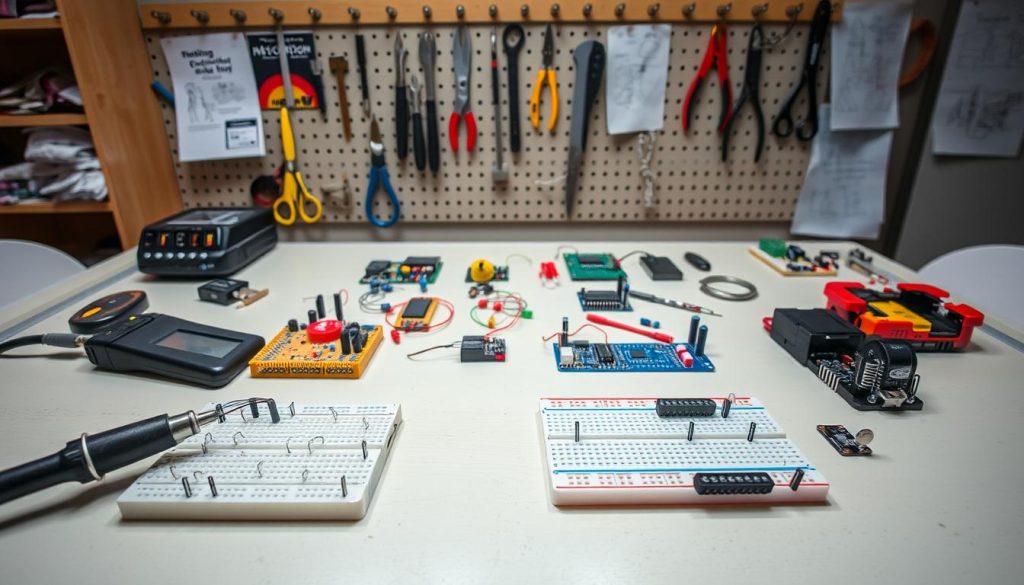Are you tired of using the same old tech gadgets at home and in the office? Can you imagine having customized devices that perfectly fit your needs and style? With the rise of homemade electronics, creating your own DIY electronic gadgets is now more accessible than ever.
Creating your own electronic projects not only allows you to personalize your tech but also provides a fun and rewarding experience. By crafting your own gadgets, you can enhance your home and office environments with unique and functional devices.
Whether you’re a hobbyist or just looking to try something new, making your own homemade electronics can be a great way to explore your creativity and develop new skills.
Key Takeaways
Table of Contents
- Personalize your tech with custom DIY projects
- Enhance your home and office with unique gadgets
- Develop new skills through hands-on electronics crafting
- Explore your creativity with homemade electronics
- Have a fun and rewarding experience making your own gadgets
Essential Tools and Materials for DIY Electronic Gadgets
Creating your own DIY electronic gadgets requires a well-stocked toolkit and a safe working environment. To start, you’ll need a variety of tools and components that will help you bring your projects to life.
Must-Have Tools for Electronics Projects
For any electronics project, having the right tools is crucial. Some of the must-have tools include a soldering iron, wire cutters, and a multimeter. A soldering iron is necessary for connecting components together, while wire cutters are used to trim wires to the right length. A multimeter is essential for measuring voltage, current, and resistance.
Basic Components Every Maker Should Own
In addition to tools, you’ll also need basic electronic components. These include resistors, capacitors, LEDs, and microcontrollers. Resistors are used to control the flow of current, while capacitors store energy. LEDs are great for adding visual feedback to your projects, and microcontrollers like Arduino or Raspberry Pi are the brains behind many DIY tech gadgets.
Setting Up Your Workspace Safely
Setting up a safe workspace is just as important as having the right tools. Ensure your workspace is well-ventilated, and keep a fire extinguisher nearby when soldering. Use an anti-static wrist strap to prevent damage to sensitive components.
By focusing on these essentials, you’ll be well-prepared to tackle a wide range of DIY electronics projects and explore various electronics tutorials and diy electronics ideas.
Beginner-Friendly Electronic Projects to Try Today
Building your own gadgets can be a rewarding experience, and it starts with simple, achievable projects. For electronic hobbyists looking to dive into DIY gadget projects, there are numerous beginner-friendly options to explore.
These projects not only introduce you to the basics of electronics but also help you develop valuable skills. Let’s take a look at three exciting projects to get you started.
Build a USB Desk Lamp with Adjustable Brightness
Creating a USB desk lamp is a great way to begin your DIY electronics journey. This project involves using a USB interface to power the lamp and implementing a brightness adjustment feature. It’s a practical project that can be completed with basic components.
Create a Simple Smartphone Amplifier
Turning your smartphone into a more robust speaker system is both fun and easy. By building a simple amplifier, you can enhance your audio experience without needing complex equipment. This project is perfect for those new to electronics.
Assemble a Basic Arduino Weather Station
For those interested in more interactive projects, assembling an Arduino weather station is an excellent choice. This project involves programming and assembling sensors to monitor temperature, humidity, and other environmental factors. It’s a great way to learn about microcontrollers and their applications.
To help you visualize the components and tools needed for these projects, here’s a comparison table:
| Project | Main Components | Skills Required |
|---|---|---|
| USB Desk Lamp | USB cable, LED, resistors | Basic soldering, circuit understanding |
| Smartphone Amplifier | Amplifier module, speakers, battery | Circuit assembly, basic electronics |
| Arduino Weather Station | Arduino board, sensors, breadboard | Programming, circuit design |
These projects are just the beginning. As you gain more experience and confidence, you can move on to more complex DIY gadget projects, exploring the vast world of electronics and innovation.
Smart Home Gadgets You Can Build Yourself
With a few simple tools and some creativity, you can build smart home gadgets that make life more convenient. These homemade tech projects not only enhance your living space but also provide a sense of accomplishment.
Voice-Controlled LED Lighting System
Creating a voice-controlled LED lighting system is a fantastic do it yourself electronics project. It involves integrating LED strips with a microcontroller like Arduino or Raspberry Pi, and a voice assistant such as Amazon Alexa or Google Assistant. This project allows you to control the lighting in your home with just your voice, adding both convenience and energy efficiency.
DIY Smart Doorbell with Camera
A creative electronic invention, a DIY smart doorbell with a camera, enhances home security. By using a Raspberry Pi or ESP32 module, you can create a doorbell that not only rings but also sends notifications to your smartphone when someone approaches. You can even add facial recognition features to identify visitors.
Automated Plant Watering System with Moisture Sensors
For plant lovers, an automated plant watering system is a great project. Using moisture sensors and a microcontroller, you can create a system that waters your plants only when necessary. This do it yourself electronics project ensures your plants stay healthy even when you’re away.
| Project | Components Needed | Skill Level |
|---|---|---|
| Voice-Controlled LED Lighting | LED Strips, Microcontroller, Voice Assistant | Intermediate |
| DIY Smart Doorbell with Camera | Raspberry Pi or ESP32, Camera Module | Advanced |
| Automated Plant Watering System | Moisture Sensors, Microcontroller, Water Pump | Intermediate |
These projects showcase the potential of homemade tech projects in creating a smarter, more automated home. By diving into these creative electronic inventions, you can tailor your home’s technology to your exact needs.
Productivity-Boosting Office Gadgets
Boosting office productivity can be as simple as creating the right gadgets. In today’s office environments, having tools that are tailored to your specific needs can make a significant difference in your work efficiency.
Custom Mechanical Keyboard with Programmable Keys
A custom mechanical keyboard can greatly enhance your typing experience. With programmable keys, you can customize shortcuts and commands to fit your workflow. As “The right keyboard can transform your workspace”, it’s an investment worth considering.
Wireless Meeting Status Indicator for Remote Work
For remote workers, a wireless meeting status indicator can help minimize interruptions during virtual meetings. This gadget signals when you’re in a meeting, ensuring a smoother workflow. “Stay connected and focused with the right gadgets.”
Desk Environmental Monitor
A desk environmental monitor tracks temperature, humidity, and air quality, creating a comfortable working environment. This gadget is essential for maintaining productivity and health.

By incorporating these DIY electronic gadgets into your office setup, you can significantly boost your productivity. Gadget making tutorials can guide you through the process, making it easier to create tools that are tailored to your needs.
Upcycling Old Electronics into New Gadgets
Upcycling old electronics is not only eco-friendly but also a creative way to produce unique gadgets for various uses. Instead of discarding outdated devices, you can breathe new life into them by transforming them into innovative and functional items.
Converting Old Smartphones into Security Cameras
One of the most practical ways to upcycle old electronics is by converting old smartphones into security cameras. With the right app and a bit of setup, you can turn your old smartphone into a surveillance device that can be monitored remotely. This not only reduces electronic waste but also provides a cost-effective security solution.
Transforming Broken Laptops into Digital Photo Frames
If you have a broken laptop lying around, consider transforming it into a digital photo frame. By repurposing the laptop’s screen and installing a digital photo frame software, you can create a beautiful and functional display for your favorite memories.
Repurposing Computer Parts for Creative Projects
Old computer parts can be repurposed for a variety of creative projects. For instance, you can use an old hard drive as a external storage device, or transform a vintage computer into a retro gaming console. The possibilities are endless, and it’s a great way to give new life to old technology.
| Old Device | Upcycled Gadget | Benefits |
|---|---|---|
| Old Smartphone | Security Camera | Enhanced Home Security, Reduced Electronic Waste |
| Broken Laptop | Digital Photo Frame | Beautiful Display, Reduced Waste |
| Old Computer Parts | External Storage/Retro Gaming Console | Creative Repurposing, Functional Utility |
By upcycling old electronics, you not only contribute to reducing electronic waste but also engage in a fun and rewarding DIY project. Whether it’s turning an old smartphone into a security camera or repurposing computer parts, the world of DIY tech gadgets is full of possibilities.
Advanced DIY Electronic Gadgets for Tech Enthusiasts
For tech enthusiasts looking to elevate their DIY skills, advanced electronic projects offer a challenging yet rewarding experience. These projects not only enhance your technical knowledge but also provide a sense of accomplishment as you see your ideas come to life.
Building a Raspberry Pi Home Media Center
One exciting project for advanced DIY enthusiasts is building a Raspberry Pi home media center. This project involves configuring your Raspberry Pi to stream media content to your TV, allowing you to access a wide range of entertainment options. With the right setup, you can enjoy your favorite movies, TV shows, and music in high definition.

Creating a Custom Home Automation Hub
Another advanced project is creating a custom home automation hub. This involves integrating various smart devices and sensors to control lighting, temperature, security, and more from a central interface. By building your own hub, you can customize the system to fit your specific needs and preferences.
Designing and Fabricating Your Own Circuit Boards
For those with experience in electronics, designing and fabricating your own circuit boards can be a fascinating project. This process involves creating custom PCBs (Printed Circuit Boards) for specific applications, such as robotics or IoT devices. With the right tools and software, you can bring your unique ideas to life.
| Project | Complexity Level | Required Skills |
|---|---|---|
| Raspberry Pi Home Media Center | Advanced | Programming, Linux knowledge |
| Custom Home Automation Hub | Advanced | IoT knowledge, programming |
| Custom Circuit Boards | Expert | Electronics design, PCB fabrication |
These advanced DIY electronic gadgets not only showcase your technical prowess but also offer practical solutions for enhancing your home and office environments. By embracing these challenging projects, you can further develop your skills and create innovative solutions tailored to your needs.
Troubleshooting and Fixing Common Electronics Issues
Troubleshooting is an essential skill for anyone diving into homemade tech projects. Whether you’re a seasoned electronic hobbyist or just starting out with DIY gadget projects, being able to identify and fix issues is crucial for success.
Diagnosing Circuit Problems with Multimeters
A multimeter is a vital tool for diagnosing circuit problems. It allows you to measure voltage, current, and resistance, helping you pinpoint where things are going wrong. Always ensure your multimeter is set to the correct range to avoid damaging it or getting inaccurate readings.
Fixing Connection Issues and Bad Solder Joints
Connection issues and bad solder joints are common problems in DIY electronics. Inspect your work carefully, looking for signs of poor soldering such as cold joints or insufficient solder. Reheating and resoldering can often resolve these issues.
When to Restart Your Project vs. When to Rebuild
Knowing when to restart a project and when to rebuild it is crucial. If the issue is isolated and easily fixable, restarting might be the best option. However, if the project is complex or has multiple problems, it might be more efficient to rebuild it from scratch.
By mastering these troubleshooting techniques, electronic hobbyists can save time and frustration, turning failed projects into successful ones.
Conclusion
Creating do it yourself electronics is a rewarding experience that combines creativity with technical skills. By building your own gadgets, you not only save money but also gain a deeper understanding of how electronics work.
Throughout this article, we’ve explored various creative electronic inventions, from simple projects like a USB desk lamp to more complex smart home gadgets. These gadget making tutorials have equipped you with the knowledge to start your DIY journey.
As you continue to explore the world of DIY electronics, remember that the possibilities are endless. Whether you’re a hobbyist or a seasoned maker, there’s always room to innovate and improve your creations. So, keep experimenting, learning, and pushing the boundaries of what’s possible with do it yourself electronics.
For those looking to dive deeper, there are numerous online resources and communities dedicated to sharing knowledge and experiences. By joining these communities, you can stay updated on the latest trends and techniques in gadget making tutorials and creative electronic inventions.

